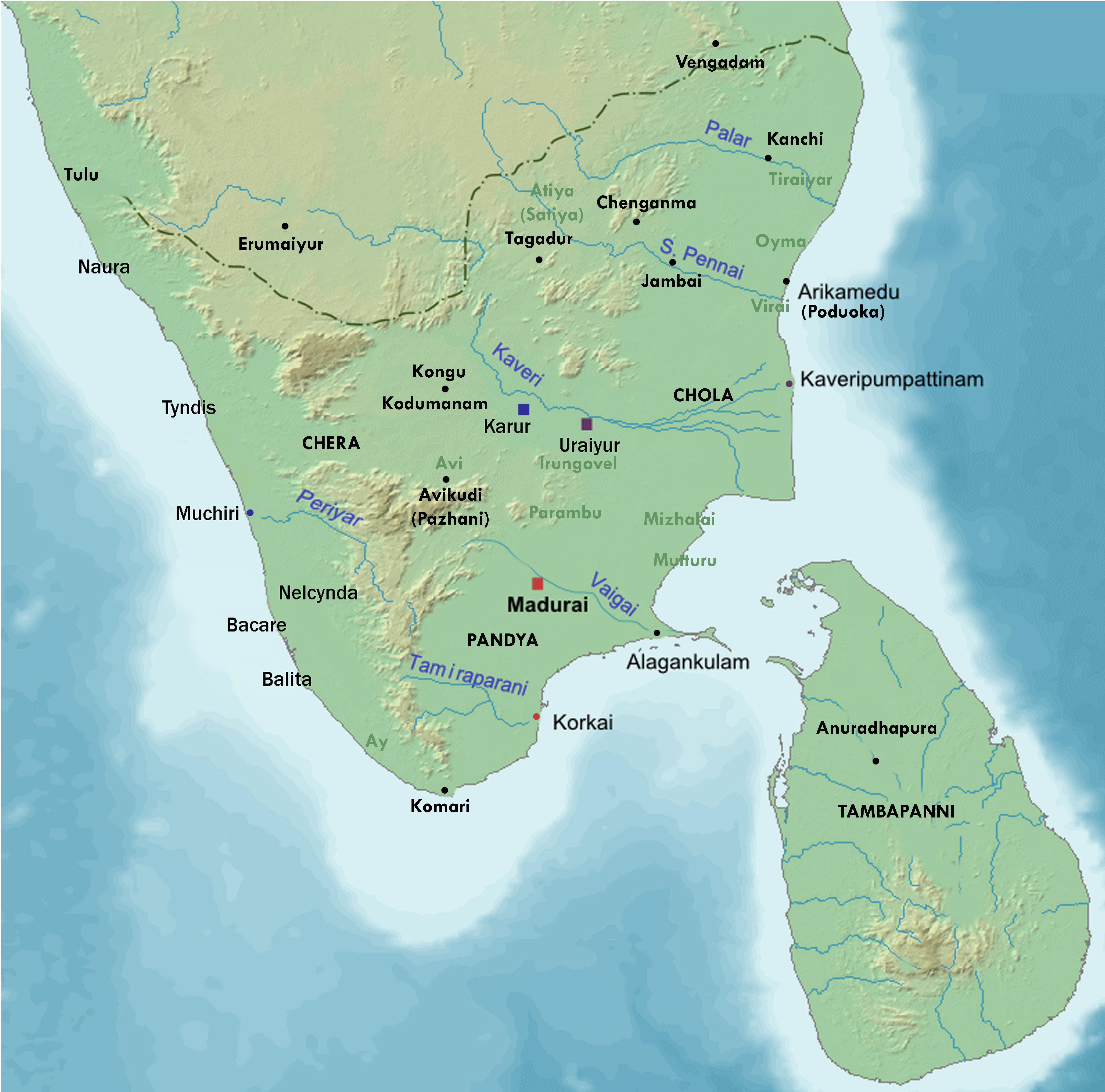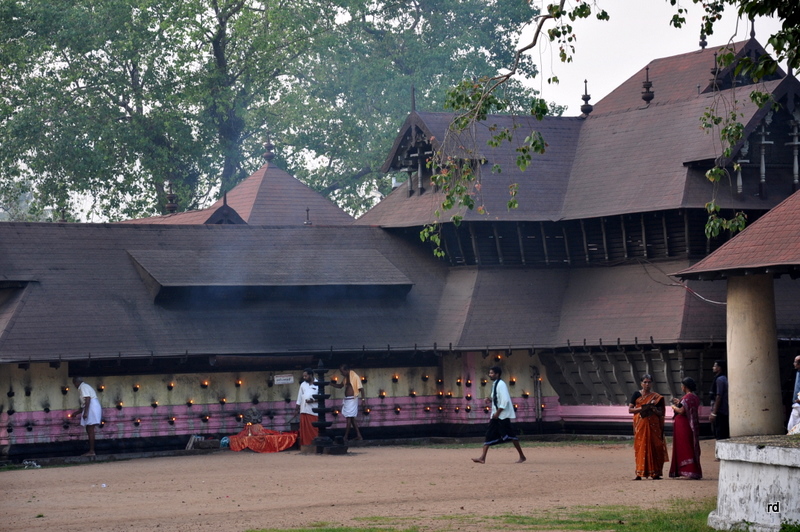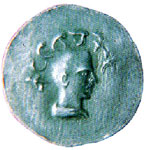|
Silappatikaram
''Cilappatikāram'' ( IPA: ʧiləppət̪ikɑːrəm, ''lit.'' "the Tale of an Anklet"), also referred to as ''Silappathikaram'' or ''Silappatikaram'', is the earliest Tamil epic. It is a poem of 5,730 lines in almost entirely ''akaval'' (''aciriyam'') meter. The epic is a tragic love story of an ordinary couple, Kaṇṇaki and her husband Kōvalaṉ. The ''Cilappatikāram'' has more ancient roots in the Tamil bardic tradition, as Kannaki and other characters of the story are mentioned or alluded to in the Sangam literature such as in the '' Natṟiṇai'' and later texts such as the ''Kovalam Katai''. It is attributed to a prince-turned-jain-monk Iḷaṅkō Aṭikaḷ, and was probably composed in the 5th century CE (although estimates range from 2nd to 6th century CE). The ''Cilappatikāram'' is an ancient literary masterpiece. It is to the Tamil culture what the ''Iliad'' is to the Greek culture, states R. Parthasarathy. It blends the themes, mythologies and theologica ... [...More Info...] [...Related Items...] OR: [Wikipedia] [Google] [Baidu] |
Kovalan
Kovalan () is a central character in Ilango Adigal's '' Silappatikaram,'' one of the ancient Tamil epics. Family Father : Machattuvan Wife : Kannagi Lover : Madhavi Daughter : Manimekalai (Mother: Madhavi) Narrative Puharkkandam Kovalan, the son of a wealthy merchant, Machattuvan, married Kannagi, the daughter of another merchant, Manayakan. At the time of his marriage, he was sixteen years old. They lived together happily in the city of Kaveripattinam, until Kovalan met the courtesan Madhavi and fell in love with her. In his infatuation, he completely forgot his wife and spent his time and parental wealth with Madhavi. During the annual festival in the honour of Indra, there was a misunderstanding between Kovalan and Madhavi. As a result, the penniless Kovalan returned to Kannagi, who welcomed him whole-heartedly. Realising his mistake, he decided to start a new life by migrating to Madurai Madurai ( , , ), formerly known as Madura, is a major city in th ... [...More Info...] [...Related Items...] OR: [Wikipedia] [Google] [Baidu] |
Kannagi
Kannagi (), sometimes spelled Kannaki, is a legendary Tamil woman who forms the central character of the Tamil epic '' Cilappatikāram''. Kannagi is described as a chaste woman who stays with her husband despite his adultery, their attempt to rebuild their marriage after her unrepentant husband had lost everything, how he is framed then punished without the due checks and processes of justice. Kannagi proves and protests the injustice, then curses the king and city of Madurai, leading to the death of the unjust Pandyan king of Madurai, who had wrongfully put her husband Kovalan to death. The society that made her suffer then endures retribution as the city Madurai, in consequence, is burnt to the ground because of her curse. In Tamil folklore, Kannagi has been deified as the symbol – sometimes as a goddess – of chastity, with sculptures or reliefs in Hindu temples iconographically reminding the visitor of her breaking her anklet or tearing her bleeding breast and throwing it ... [...More Info...] [...Related Items...] OR: [Wikipedia] [Google] [Baidu] |
Kannagi (Tamil Mythology)
Kannagi (), sometimes spelled Kannaki, is a legendary Tamil people, Tamil woman who forms the central character of the Tamil epic poetry, epic ''Cilappatikāram''. Kannagi is described as a chaste woman who stays with her husband despite his adultery, their attempt to rebuild their marriage after her unrepentant husband had lost everything, how he is framed then punished without the due checks and processes of justice. Kannagi proves and protests the injustice, then curses the king and city of Madurai, leading to the death of the unjust Pandya dynasty, Pandyan king of Madurai, who had wrongfully put her husband Kovalan to death. The society that made her suffer then endures retribution as the city Madurai, in consequence, is burnt to the ground because of her curse. In Tamil folklore, Kannagi has been deified as the symbol – sometimes as a goddess – of chastity, with sculptures or reliefs in Hindu temples iconographically reminding the visitor of her breaking her anklet or te ... [...More Info...] [...Related Items...] OR: [Wikipedia] [Google] [Baidu] |
Cheran Chenkutuvan
Chenkuttuvan (c. 180 CE, literally 'the Righteous Kuttuvan'), title Kadal Pirakottiya, identified with Kadalottiya Vel Kezhu Kuttuvan, was the most celebrated Chera ruler of early historic South India. He is also mentioned in Chilappathikaram, the Tamil epic poem purportedly composed by the Chera prince Ilanko Adikal''.'' Chenkuttavan is eulogized by the poet Paranar in the fifth decade of the Pathitrupathu Collection, part of the Ettuthokai anthology of early Tamil literature. He was likely a member of the Muchiri-Karur branch (associated with present-day central Kerala) of the Chera dynasty. During his reign, the Chera territory encompassed the Malabar Coast (present-day Kerala) and the interior Kongu country (western Tamil Nadu). The influx of Yavana (Greco-Roman) gold into south India through the Indian Ocean spice trade during Chenkuttavan's reign is memorably described in ancient Tamil poems. According to Fifth Decade, Pathitrupathu, Chenkuttavan achieved a majo ... [...More Info...] [...Related Items...] OR: [Wikipedia] [Google] [Baidu] |
Patiṟṟuppattu
The ''Patiṟṟuppattu'' (lit. ''Ten Tens'', sometimes spelled ''Pathitrupathu'',) is a classical Tamil poetic work and one of the Eight Anthologies (''Ettuthokai'') in Sangam literature. A panegyric collection, it contains ''puram'' (war and public life) poems. The Chera kings, known as the Cheramal, are the centre of the work. Its invocatory poem is about Mayon, or Perumal (Vishnu). The ''Patiṟṟuppattu'' originally contained ten sections of ten poems, each section dedicated to a decade of rule in ancient Kerala (Cerals, Chera); the first and last sections have been lost. Of the surviving poems, the second-to-sixth-decade-related poems are about the three generations of rulers from the Imayavaramban dynasty. The remaining poems are about the three generations of rulers from the Irumporai dynasty. In the ''Patirruppattu'' palm-leaf manuscripts, each decade ends with a (a verse epilogue followed by a prose colophon. According to U. V. Swaminatha Iyer (who rediscov ... [...More Info...] [...Related Items...] OR: [Wikipedia] [Google] [Baidu] |
Sangam Literature
The Sangam literature (Tamil language, Tamil: சங்க இலக்கியம், ''caṅka ilakkiyam''), historically known as 'the poetry of the noble ones' (Tamil language, Tamil: சான்றோர் செய்யுள், ''Cāṉṟōr ceyyuḷ''), connotes the early classical Tamil literature and is the earliest known literature of South India. The Tamil tradition links it to Legendary Tamil Sangams, legendary literary gatherings around Madurai in the ancient Pandya dynasty, Pandya kingdom. It is generally accepted by most scholars that the historical Sangam literature era, also known as the Sangam period, spanned from 100 BCE to 250 CE, on the basis of linguistic, epigraphic, archaeological, numismatic and historical data; though some scholars give a broader range of 300 BCE to 300 CE. The Eighteen Greater Texts (Patiṉeṇmēlkaṇakku), along with the Tamil grammar work Tolkāppiyam, Tolkappiyam, are collectively considered as Sangam literature. These tex ... [...More Info...] [...Related Items...] OR: [Wikipedia] [Google] [Baidu] |
Manimekalai
''Maṇimēkalai'' (, ), also spelled ''Manimekhalai'' or ''Manimekalai'', is a Tamil Buddhist epic composed by Kulavāṇikaṉ Seethalai Sataṉar probably somewhere between the 2nd century to the 6th century. It is an "anti-love story", a sequel to the "love story" in the earliest Tamil epic '' Cilappatikaram'', with some characters from it and their next generation. The epic consists of 4,861 lines in ''akaval'' meter, arranged in 30 cantos. The title ''Manimekalai'' is also the name of the daughter of Kovalan and Madhavi, who follows in her mother's footsteps as a dancer and a Buddhist nun. The epic tells her story. Her physical beauty and artistic achievements seduces the Chola prince Udayakumara. He pursues her. She, a nun of Mahayana Buddhism persuasion, feels a commitment to free herself from human ties. She rejects his advances, yet finds herself drawn to him. She hides, prays and seeks the help of her mother, her Buddhist teacher Aravana Adikal and angels. They ... [...More Info...] [...Related Items...] OR: [Wikipedia] [Google] [Baidu] |
Sangam Period
The Sangam literature ( Tamil: சங்க இலக்கியம், ''caṅka ilakkiyam''), historically known as 'the poetry of the noble ones' ( Tamil: சான்றோர் செய்யுள், ''Cāṉṟōr ceyyuḷ''), connotes the early classical Tamil literature and is the earliest known literature of South India. The Tamil tradition links it to legendary literary gatherings around Madurai in the ancient Pandya kingdom. It is generally accepted by most scholars that the historical Sangam literature era, also known as the Sangam period, spanned from 100 BCE to 250 CE, on the basis of linguistic, epigraphic, archaeological, numismatic and historical data; though some scholars give a broader range of 300 BCE to 300 CE. The Eighteen Greater Texts (Patiṉeṇmēlkaṇakku), along with the Tamil grammar work Tolkappiyam, are collectively considered as Sangam literature. These texts are classified into the Ettuttokai (Eight Anthologies) and Pattupattu (T ... [...More Info...] [...Related Items...] OR: [Wikipedia] [Google] [Baidu] |
Chera Dynasty
The Chera dynasty ( or Cēra, ), also known as Keralaputra, from the early historic or the Sangam period in Tamil-speaking southern India, ruled over parts of present-day states Kerala and Tamil Nadu. The Cheras, known as one of the mu-ventar (the Three Crowned Kings) of Tamilakam (the Tamil Country) alongside the Cholas and Pandyas, have been documented as early as the third century BCE. The Chera country was geographically well placed at the tip of the Indian peninsula to profit from maritime trade via the extensive Indian Ocean networks. Exchange of spices, especially black pepper, with Middle Eastern or Graeco-Roman merchants is attested to in several sources. Chera influence extended over central Kerala and western Tamil Nadu until the end of the early historic period in southern India. The Cheras of the early historical period (c. second century BCE – c. third/fifth century CE) had their capital in interior Tamil country ( Vanchi-Karur, Kongu Nadu), and ports/capit ... [...More Info...] [...Related Items...] OR: [Wikipedia] [Google] [Baidu] |
Ilango Adigal
Ilango Adigal (a title, literally "prince ascetic", fl. c. 4th-6th century CE) was a Jain monk, belonging to the Chera royal family, from the city of Vanchi. He is traditionally credited as the author of the epic poem Cilappatikaram (the Song of the Anklet), one of the Five Great Epics of Tamil literature. In the patikam (the prologue) to the poem, Ilango Adigal identifies himself as the brother of the Chera king Cenkuttuvan (c. late 2nd century CE). However, it is generally assumed that the author was a member of the Chera royal family who lived much later than Cenkuttuvan and composed the poem based on a reliable version of the historical tradition concerning Cenkuttuvan and Kannaki. Biography No directly verifiable information about Ilango Adigal exists outside of Cilappatikaram ("The Lay of the Anklet") and its prologue. According to the text, Ilango Adigal was a Chera prince ("Kudakko Ceral Ilanko"). He was the younger son of the Chera king "Imayavarampan" Ce ... [...More Info...] [...Related Items...] OR: [Wikipedia] [Google] [Baidu] |
Anklet
An anklet, also called ''ankle chain'', ''ankle bracelet'' or ''ankle string'', is an ornament worn around the ankle. Barefoot anklets and toe rings historically have been worn for at least over 8,000 years by girls and women in Indus Valley, in Indian Subcontinent where it is commonly known as ''pattilu'', ''payal, golusu'' and sometimes as ''nupur''. They have also been worn by Egyptian women since predynastic times. In the United States both casual and more formal anklets became fashionable from the 1930s to the late–20th century. While in Western popular culture both younger men and women may wear casual leather anklets, they are popular among barefoot women. Formal anklets (of silver, gold, or beads) are used by some women as fashion jewellery. Anklets are an important piece of jewellery in Indian marriages, worn along with saris. Occasionally, anklets on both ankles are joined by a chain to limit the step. This practice was once prevalent in Southeast Asia, where th ... [...More Info...] [...Related Items...] OR: [Wikipedia] [Google] [Baidu] |






